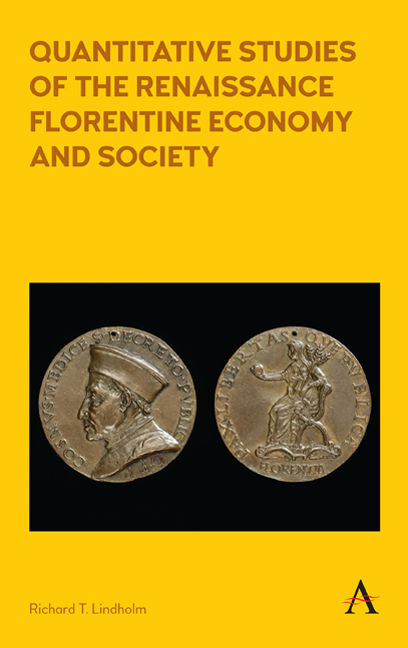Book contents
- Frontmatter
- Dedication
- Contents
- List of Illustrations
- Preface
- Acknowledgments
- List of Abbreviations
- Introduction
- Part I RISKS AND RETURNS
- Part II SOCIETY
- Part III WORK
- Chapter Seven Just Doing Business: Testing Competition in the Renaissance Florentine Wool Industry
- Chapter Eight Time for It All: Women in the Renaissance Florentine Wool Industry
- Chapter Nine Why Were Renaissance Florentine Wool Industry Companies So Small?
- Conclusion
- Glossary
- Bibliography
- Index
Chapter Eight - Time for It All: Women in the Renaissance Florentine Wool Industry
from Part III - WORK
Published online by Cambridge University Press: 10 January 2018
- Frontmatter
- Dedication
- Contents
- List of Illustrations
- Preface
- Acknowledgments
- List of Abbreviations
- Introduction
- Part I RISKS AND RETURNS
- Part II SOCIETY
- Part III WORK
- Chapter Seven Just Doing Business: Testing Competition in the Renaissance Florentine Wool Industry
- Chapter Eight Time for It All: Women in the Renaissance Florentine Wool Industry
- Chapter Nine Why Were Renaissance Florentine Wool Industry Companies So Small?
- Conclusion
- Glossary
- Bibliography
- Index
Summary
Introduction
The role of women in society and how that role evolved over time is a fundamental question in Italian Renaissance historiography. Finding whether that role was expanding, contracting, unchanged or moving into new areas provides an important insight into discovering the heart of what the Renaissance means. The role of working women is a critical component of any such research agenda because it occupies the most common and frequently observed margin between the worlds of men and of women.
Burckhardt's nineteenth-century observation that women gained increasing equality during the Renaissance began the discussion. However, his view has been challenged in recent years. Joan Kelly-Gadol questions whether women even had a Renaissance and whether the term can mean anything for women. She argues that the new Renaissance society, better suited to a world with an expanding urban economy and shrinking nobility, reduced options for women. Cohn argues that Burckhardt overestimated the social changes in the case of Renaissance Florence. However, Herlihy argues persuasively that women did have a Renaissance in at least one area—that of charisma. The roles in society assumed by Catherine of Siena and Joan of Arc were unique to that time.
Much of the research to date has concentrated on big-picture examinations of the Renaissance. Those results have been applied then to individual cases. This approach can leave surprising lacunae. For example, Goldthwaite points out that working women in Renaissance Florence have not been well studied. Given the great regional diversity in government structures and social conventions in Europe during the late medieval and early modern periods, some specificity regarding the place and time of the research focus is clearly important.
This chapter's study exploits a source of dynamic data to reveal that women used their time differently than men. As in Chapter 7, the Medici-Tornaquinci wool industry account books are used, this time to study working women from the mid-Cinquecento Florentine wool industry. The more commonly used static data sources could not permit this kind of analysis.
Though it examines other occupations held by women, this study focuses on weavers. Research on late medieval and Renaissance working women often necessitates using small samples.
- Type
- Chapter
- Information
- Publisher: Anthem PressPrint publication year: 2017



